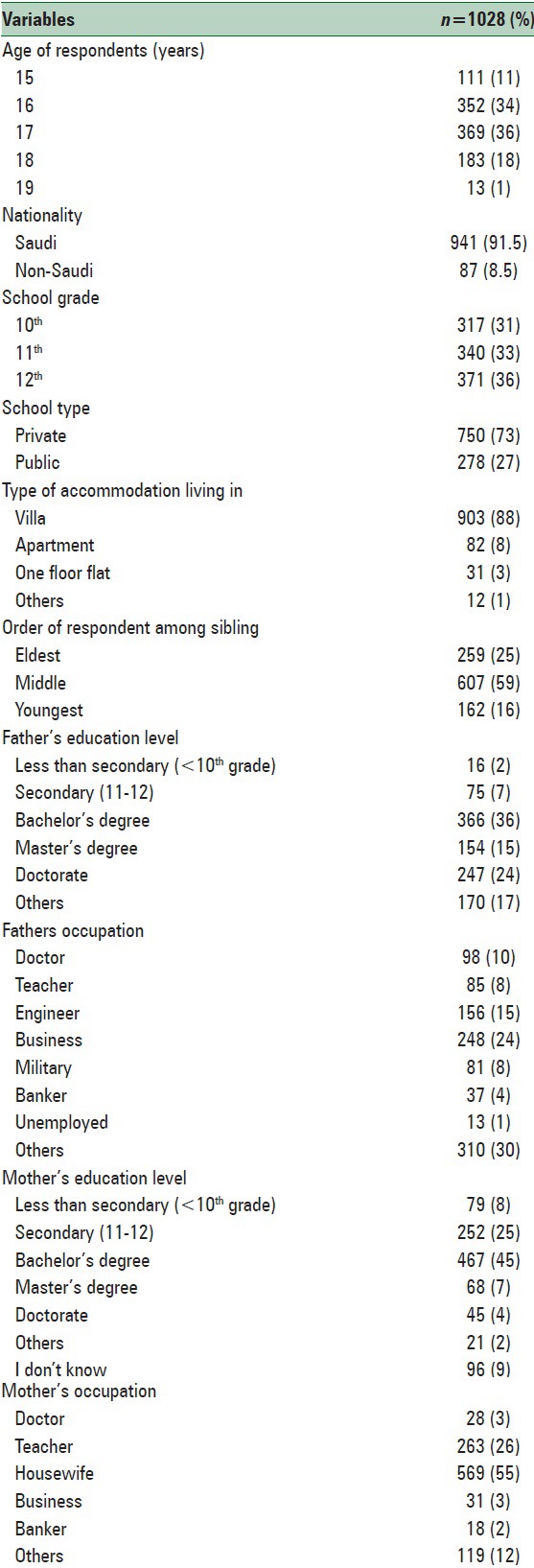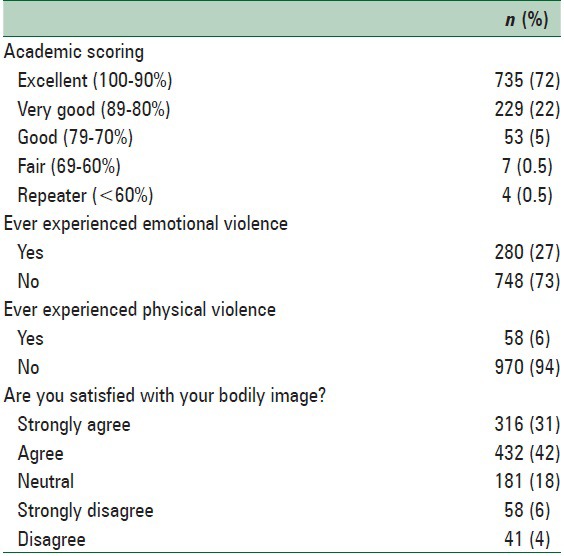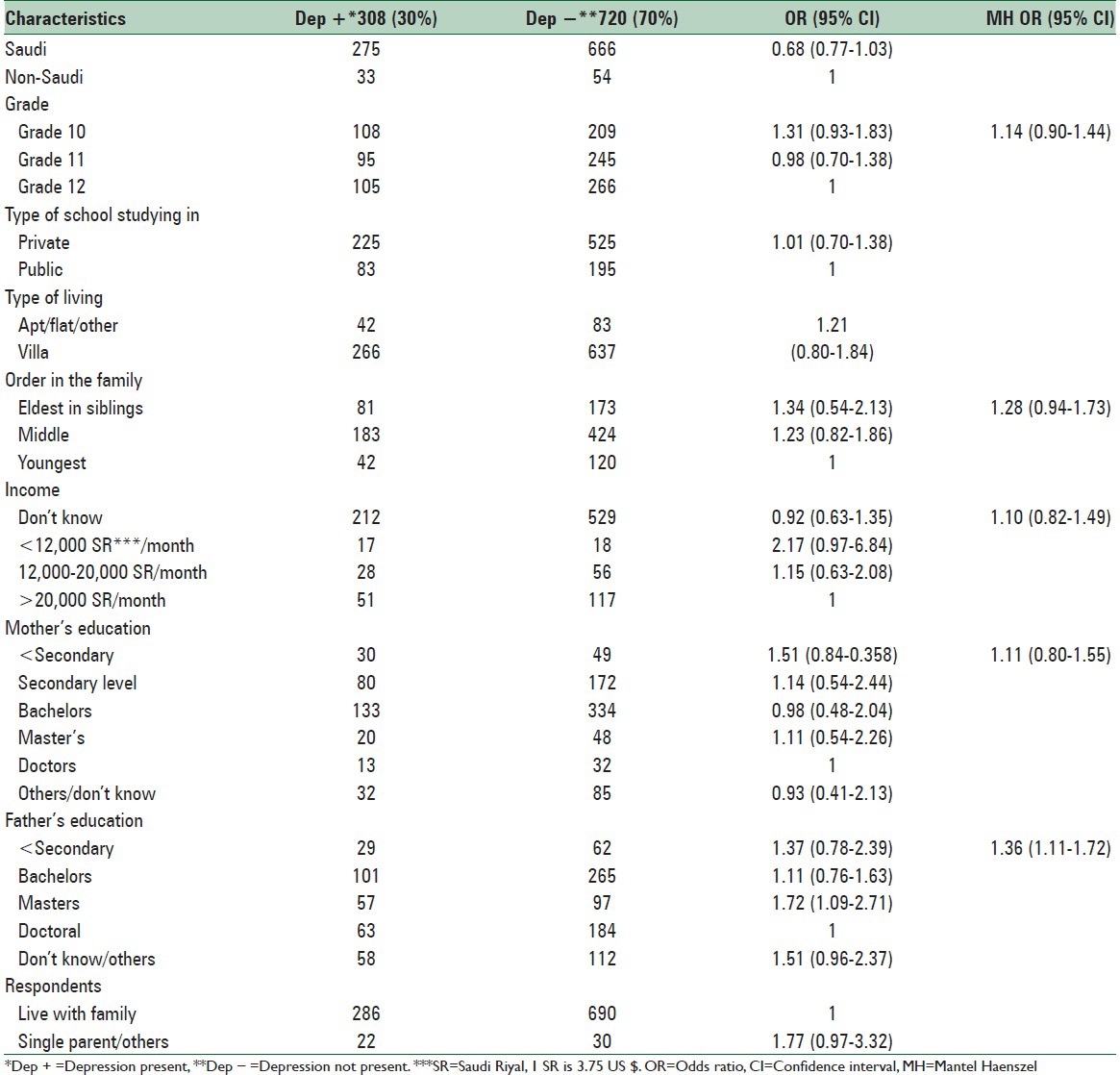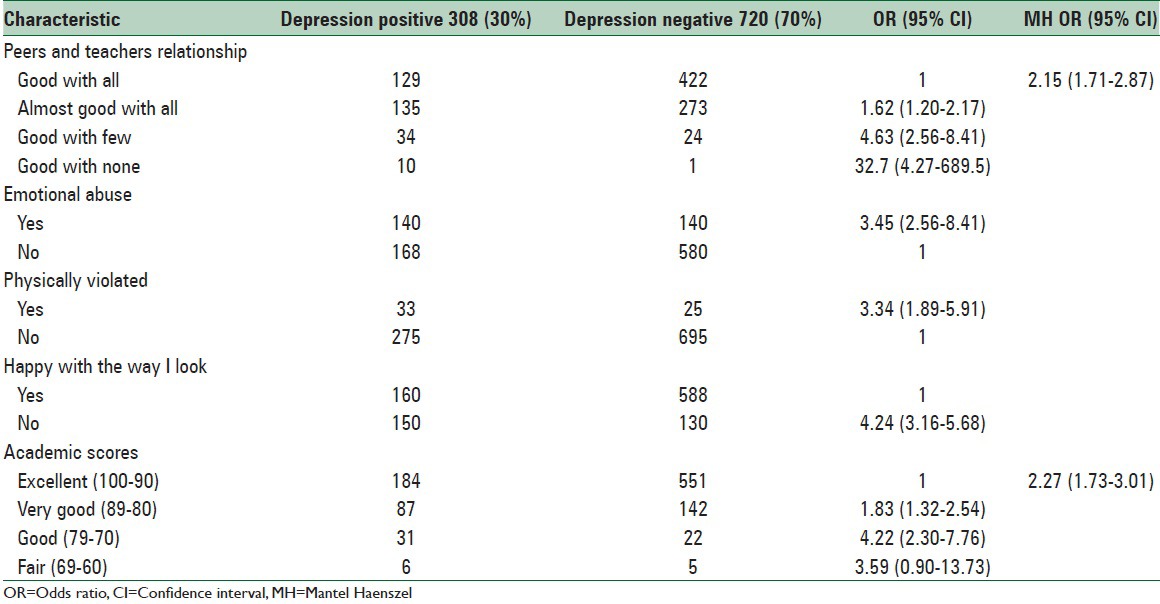Abstract
Background:
Adolescents who suffer from depression early in life, have an increase in suicidal tendency, anxiety, conduct disorders, substance abuse, and continue to be depressed, later on in life. This study was conducted to identify the prevalence and correlates of depression among adolescent girls in Riyadh city in order to carry out early intervention.
Methods:
A cross-sectional, school-based survey was conducted among 1028 adolescent girls aged 15–19 years in secondary schools of Riyadh city. Riyadh was divided into clusters and within each cluster, both public and private schools were enrolled. From the selected schools students from grade 10–12 were surveyed. Survey was conducted using a structured questionnaire including the beck depression inventory-II, and questions exploring the correlates of depression.
Results:
About 30% of participants were found to be depressed. Depression was more prevalent among female adolescents whose household income was <12,000 Saudi Riyal/month (odds ratio [OR] 2.17, confidence interval [CI] 0.97–6.84), did not have a good relationship with peers and family members (OR 4.63, CI 2.56–8.41), lived with single parent or alone (OR 1.77, CI 0.97–3.23), been emotionally abused (OR 3.45, CI 2.56–8.41), and those who had been subjected to physical violence, at least once (OR 3.34, CI 1.89–5.91).
Conclusions:
Strategies need to be developed to identify early signs and symptoms of depression among Saudi female adolescents. Training can be given to groups of students to help their peers, and also to the teachers to identify, and help students identify early signs of depression and provide them with better-coping strategies to combat progression of depression and anxiety among such adolescents.
Keywords: Adolescents, depression, Saudi Arabia
INTRODUCTION
Adolescents need good mental health to build normal emotional and mental development, to develop their potential, to have fulfilling relationships with peers and family, and to deal with the challenges of future life. The 2011 report on the State of World Child, UNICEF reports that around 20% of the world's adolescents have mental health or behavioral problem. Depression is said to be a single largest contributor to the global burden of disease among people aged 15–19 years. [1] Global and regional studies report the existence of depression and anxiety among adolescents (14–19 years). [2,3,4,5,6,7,8,9]
Looking at the consequences of depression among adolescents, it is stated that those who are affected with depression early in life, often suffer from depression throughout their lives and in many cases, early onset of depression predicts more severe depression during adulthood. Other than an increase in suicidal tendency, youth who are depressed are at a higher risk of mental disorders such as anxiety, conduct disorders, and substance abuse. [10,11] Therefore, early screening to identify and treat depression is needed to prevent the development of adulthood depression and other mental disorders. Scientific literature has also shown that female adolescents are found to be suffering from depression and other mental health problems more than their male counterparts. [5,12] Factors such as academic performances, parental education, parental relationships, and low socioeconomic status have been seen to be risk factors associated with adolescent depression. [5,7]
After reviewing the available local data, and identifying that there is dearth of data on adolescent mental health particularly female adolescents in the Kingdom, we conducted a community-based survey to estimate the burden of depression and also to explore the correlates of depression among female adolescents in Riyadh.
METHODS
A cross-sectional, school-based survey was conducted among the secondary school girls aged 15–19 years in Riyadh city. Riyadh is the capital of the Kingdom of Saudi Arabia (KSA) and has a population of about 7 million people. It is the center of education for the country with one of the best educational opportunities available. The educational system of the country has separate schools and universities for males and females, from primary to higher secondary and university level.
For the sake of a geographically representative sample, Riyadh was divided into five clusters, south, east, north, west, and central. A list of secondary schools (having educational classes till 12th grade) was obtained from the Ministry of Higher Education. We tried to enroll at least one private and one public school from within each cluster. Convenient sampling was done while selecting these schools. A total of 1028 students were enrolled in the survey. Assuming 25% prevalence of depression, with ± 4% level of precision, and at 95% level of confidence, 450 subjects were needed. By considering the inflation fraction (due to cluster sample) of 2, and with 15% nonresponse rate, we needed to have 1035 study subjects.
Schools selected were approached after obtaining approval from the ministry of higher education and school administration. Within each school, a list of students in grades 10–12 was obtained and within each class every alternate student according to the class enrollment sheet was offered to participate in the survey. Participation was voluntary.
Girls of grades 10–12, irrespective of the language and nationality were enrolled. Those who were suffering from any mental conditions such as schizophrenia and phobia were excluded from the survey. Data were collected from November 2012 to February 2013.
A detailed questionnaire was developed to be used as a self-administered tool. It consisted of three parts;
The first part consisted of variables related to the sociodemographic profile of the participants such as age, nationality, school grade, type of school, marital status, number of children if married, accommodation, respondents’ living structure, parents education, family income, previous history of depression, academic scores, and history of medication, especially usage of antidepressants.
The second part was the beck depression inventory (BDI). Depressive symptoms were assessed using the BDI-II. [13] The BDI-II was initially developed for use with adults and has well-established psychometric properties. [14] Several studies have shown it to have acceptable internal consistency, test – retest reliability, easy to use and low cost, and construct validity with adolescents. [15,16,17,18] In the present study, minor modifications were made to the original BDI-II. Items which asked about sexual interest were removed which was inappropriate to be asked in the Saudi culture. The Arabic version of the BDI, which has been validated in a previous study, was used in the current study. [18]
The third section was to assess the risk factors related with depression among the respondents. It consisted of; evaluation of relationship with family members, relationship with teachers and classmates, stressful life events, physical and verbal abuse, satisfaction about body images, coping with stress, physical activity, and presence of chronic illness in the participants and their families.
The questionnaire was constructed based on evidence from literature and consultations provided from field experts. It was piloted in a similar setting of adolescent female students. The school, where the piloting was done, was excluded from the actual survey. Piloting was done on 10% of the sample size. After the piloting, changes in question formatting and rephrasing were done. Informed consent was obtained from the respondents and a code was assigned to each questionnaire, the code was entered in the data system, this was to ensure anonymity of the respondents. Ethical approval was obtained from the University ethical approval board.
Data were analyzed using the Statistical Package for Social Sciences version 20 (IBM SPSS statistics 20, USA). Pearson Chi-square and odds ratio (OR) were used to observe and measure the association between categorical and outcome association. Multivariate logistic regression analysis was done. A P < 0.5 and 95% confidence interval (CI) was used to report the significant and precision of the estimates.
RESULTS
Table 1 shows the sociodemographic data of the participants; about 904 (88%) of the respondents were of 16–18 years of age. Two-thirds (73%) of the participants were enrolled in private schools.
Table 1.
Sociodemographic data of participants

Fathers, 767 (75%) and mothers, 580 (56%) of a majority of the participants are well-educated with Bachelors or higher levels, with many having professional degrees such as physicians and teachers (mother, 291 (29%), fathers 339 (33%)). 903 (88%) of these participants live in villas.
Most of these girls are doing well in their studies with more than 94% achieving very good or excellent marks in their formative and summative assessments [Table 2].
Table 2.
Education of respondents and exposure to factors known to cause mental health illness

280 (27%) of the girls reported being exposed to emotional violence including verbal abuse; whereas 58 (6%) reported sexual abuse or physical violence at some time in their life.
Many (15%) of the girls reported having episodes of tension headache/migraine, 20 (2%) of the adolescent participants had hypothyroidism, and 30 (3%) had some form of bone disease. Around 127 (11%) reported to be suffered from Asthma.
Table 3 shows the bivariate and multivariate logistic regression analysis. Depression was more prevalent among adolescents whose household income was <12,000 Saudi Riyal (SR)/month (OR 2.17, CI 0.97–6.84), those who did not have a good relationship with peers and family members (OR 4.63, CI 2.56–8.41), those who lived with single parent or alone (OR 1.77, CI 0.97–3.23), those who had been emotionally abused (OR 3.45, CI 1.89–5.91), and those who had been exposed to physical violence (OR 3.34, CI 1.89–5.91). Age and marital status of the respondents did not show any significant association with depression.
Table 3.
Relationship between sociodemographic characteristics of respondents and depression diagnosed by beck inventory scale

In the final multivariate model [Table 4], significant depression among adolescents who participated in this study was associated with not having good relationships with peers and family (OR 2.15, CI 1.71-2.87), not being happy with their body images (OR 4.24, CI 3.16-5.68), and relatively poor academic progress (OR 3.59, CI 0.9-13.73).
Table 4.
Association of personal characteristics of the respondents with depression

DISCUSSION
To the best of our knowledge, this is the first study that has explored the prevalence and risk factors of depression among adolescent girls in Riyadh, Saudi Arabia. We found that 30% of the adolescent girls were depressed. This is a high percentage as compared to an earlier study conducted in Abha among Saudi adolescent girls, which reported a prevalence of 13%. [19] However, the percentage in the current study is less than that reported by Al Gelban, who surveyed adolescent boys in the same region and reported 38% being depressed. [20] A study conducted by Afifi et al. in Oman also has reported that approximately 19% of the adolescent surveyed girls being depressed. [8] The relatively higher figure for depression in the current study compared to other studies could be due to a number of reasons. First, we have conducted the survey among adolescent girls who are school going, and most of the participants are residents of Riyadh. Riyadh, being the capital of the country can be thought of having a population which is relatively better educated and more verbal in reporting and accepting such sensitive issues compared to the other areas of the country. The norms and the lifestyle of adolescents are different from other parts of the country; therefore, the level of depression can also be different. Another factor could be the difference in the scale which has been used to determine the diagnosis depression in the various studies. We adopted a scale with minimal sensitive questions to determine depression among the respondents. Therefore, their confidence and resistance in answering the question were minimal. Another important point is that the data collection was done by adolescent girls who were almost of the same age group. They were trained to ask and explore the respondents in a friendly manner, and to handle sensitive information. This could also have led to better reporting by the respondents, thus minimizing bias, as they may have felt that the information was secure there could be a feeling of trust was felt between the respondents and the interviewer.
The current study found that adolescent girls, who were from families with lower income (<12,000 SR/month) as well as those whose families were living in apartments were found to be having depression, compared to the girls from families which were relatively richer and living in villas. A research by Bayram and Bilgel with the university students in Turkey found that the students from families with poor socioeconomic background had higher depression scores. [21] Other studies have also pointed out that socioeconomic status is a strong predictor of depression and other mental health problems in low- and middle-income countries. [22,23]
In a way, the findings of the current study are surprising. KSA is ranked as a high-income country, and it is generally considered that that the community is better off with regard to assets and living standards, compared to other countries. Another point to emphasize here is that our study population was privileged, and school going, which is different from the rural population, which can be assumed to be belonging to a lower socioeconomic class. However, our finding that within the different socioeconomic strata, the ones in the lower income group families were found to be depressed is also interesting. This finding points out to the need to conduct more research to explore what factors are related to depression among this group of adolescent girls.
The role of mothers education toward depression among adolescent girls came out as more significant compared to the education status of fathers. Mothers education status has been cited as an influencing factor on children's mental health. [24] Mothers who are educated are said to be better off in handling day to day stressful events and also with regard to providing better emotional support to their children at homes. [25,26] Our study has pointed out to the same fact that adolescent girls whose mothers were relatively less educated were more depressed compared to those whose mothers were graduates. Our results also showed that adolescent girls who were depressed had fathers who had a higher level of education. This indicates the lack of influence of fathers educational status can have on the mental health of his children. A possible and more relevant explanation of this finding in the Saudi context can also be explained on the cultural basis, whereby daughters are more attached to mothers for emotional and all other support. It would be interesting to explore if this association is also present in male adolescents. Another possibility could be that fathers are more occupied with their work, giving lesser time to their children, so the influence of their educational level is less evident on the mental health of the children.
The association that we found in this study between the body image and being subject to physical and/or emotional violence points to a possible lower self-esteem and perceptions about self, due to such violence. Both body image and the exposure to violence were found to be associated with the development of depression among young people. [12,27,28] In addition, it could be said that being subjected to violence causes people to suffer from lower self-esteem and poor perception of self-image. Therefore, violence could be considered as a risk factor for developing mental health problems directly as well as through undermining confidence and self-esteem. The depression among the Saudi adolescent girls in the current study was found to be associated with negative self-perception of body image, and exposure to emotional or physical violence.
As is reported by other studies,[29,30] the current study has pointed to a highly significant association between depression and relationship with peers and family. In these studies girls who did not have good relationships with parents, peers, and teachers reported to have more depression compared to those who enjoyed a good relationship with all of the above. The relationships work by providing support and ways to communicate and discuss day-to-day life events and stressors. In KSA, the relationships with fellow students are probably even more important as adolescent girls may not have opportunities beyond school for developing trusting relationships with other girls in the neighborhood, resulting in a further lack of socialization.
LIMITATIONS
Despite the fact that the current study has pointed out to a very important yet relatively untouched area in adolescent mental health in Saudi Arabia, the study does have some limitations. It has only addressed the risk factors for depression among female Saudi adolescents, which might differ from the risk factors for depression among Saudi adolescent boys. This study has not explored the prevalence of depression and the related risk factors among rural adolescents of Saudi Arabia. As we have conducted our study in the capital city of Saudi Arabia, its results may not be generalizable to other parts of the Kingdom and globally.
CONCLUSIONS
This is the first detailed community-based study which has explored depression and its risk factors among Saudi adolescent girls. Strong parental support along with peer support serves as a protective mechanism toward adolescence depression. We need to identify violence and its perpetuities and develop interventions to stop it at all levels. Adolescent girls need to be trained as to how to handle such incidences, where to report and from whom to seek immediate help. Programs at the school level targeted to identify mental health issues and stresses among students need to be implemented in the Kingdom. Students can be trained to help their peers, teachers can also be trained through workshops to identify, and help students who are depressed and need help by providing coping strategies which are culturally acceptable and practical to address depression and anxiety among adolescents.
It is also important to work with the community, families and the relevant health and welfare departments and education sector to raise awareness about the importance of good mental health for adolescents in order to prevent and protect them from getting mental health illnesses.
ACKNOWLEDGEMENTS
A big thanks to Dr. Muhammad Afzal Mahmood, who has given great input in the manuscript preparation. Thanks to Dr. Amna Rehana, who was kind enough to help in the logistic regression analysis.
Footnotes
Source of Support: Nil
Conflict of Interest: None declared.
REFERENCES
- 1.New York: [Last accessed on 2013 Aug 20]. UNICEF 2011, The State of World's Children -adolescence: An age of opportunity. Available from: http//www.unicef.org/SOWC-2011 . [Google Scholar]
- 2.Merikangas KR, He JP, Burstein M, Swanson SA, Avenevoli S, Cui L, et al. Lifetime prevalence of mental disorders in U.S. adolescents: Results from the National Comorbidity Survey Replication - Adolescent Supplement (NCS-A) J Am Acad Child Adolesc Psychiatry. 2010;49:980–9. doi: 10.1016/j.jaac.2010.05.017. [DOI] [PMC free article] [PubMed] [Google Scholar]
- 3.Eapen V, Jakka ME, Abou-Saleh MT. Children with psychiatric disorders: The A1 Ain Community Psychiatric Survey. Can J Psychiatry. 2003;48:402–7. doi: 10.1177/070674370304800607. [DOI] [PubMed] [Google Scholar]
- 4.Spady DW, Schopflocher DP, Svenson LW, Thompson AH. Prevalence of mental disorders in children living in Alberta, Canada, as determined from physician billing data. Arch Pediatr Adolesc Med. 2001;155:1153–9. doi: 10.1001/archpedi.155.10.1153. [DOI] [PubMed] [Google Scholar]
- 5.Frigerio A, Rucci P, Goodman R, Ammaniti M, Carlet O, Cavolina P, et al. Prevalence and correlates of mental disorders among adolescents in Italy: The PrISMA study. Eur Child Adolesc Psychiatry. 2009;18:217–26. doi: 10.1007/s00787-008-0720-x. [DOI] [PubMed] [Google Scholar]
- 6.Ford T, Goodman R, Meltzer H. The British Child and Adolescent Mental Health Survey 1999: The prevalence of DSM-IV disorders. J Am Acad Child Adolesc Psychiatry. 2003;42:1203–11. doi: 10.1097/00004583-200310000-00011. [DOI] [PubMed] [Google Scholar]
- 7.Eskin M, Ertekin K, Harlak H, Dereboy C. Prevalence of and factors related to depression in high school students. Turk Psikiyatri Derg. 2008;19:382–9. [PubMed] [Google Scholar]
- 8.Afifi M, Al Riyami A, Morsi M, Al Kharusil H. Depressive symptoms among high school adolescents in Oman. East Mediterr Health J. 2006;12(Suppl 2):S126–37. [PubMed] [Google Scholar]
- 9.Bodur S, Kucukkendirci H. Prevalence of Depressive Symptoms in Turkish Adolescents. Eur J Gen Med. 2009;6:204–12. [Google Scholar]
- 10.Lewinsohn PM, Rohde P, Klein DN, Seeley JR. Natural course of adolescent major depressive disorder: I. Continuity into young adulthood. J Am Acad Child Adolesc Psychiatry. 1999;38:56–63. doi: 10.1097/00004583-199901000-00020. [DOI] [PubMed] [Google Scholar]
- 11.Weissman MM, Wolk S, Goldstein RB, Moreau D, Adams P, Greenwald S, et al. Depressed adolescents grown up. JAMA. 1999;281:1707–13. doi: 10.1001/jama.281.18.1707. [DOI] [PubMed] [Google Scholar]
- 12.Stice E, Hayward C, Cameron RP, Killen JD, Taylor CB. Body-image and eating disturbances predict onset of depression among female adolescents: A longitudinal study. J Abnorm Psychol. 2000;109:438–44. [PubMed] [Google Scholar]
- 13.Beck AT, Rush AJ, Shaw BF, Emery G. New York: Guilford Press; 1979. Cognitive Therapy of Depression. [Google Scholar]
- 14.Beck AT, Steer RA, Garbin MG. Psychometric properties of the Beck Depression Inventory: Twenty-five years of valuation. Clin Psychol Rev. 1988;8:77–100. [Google Scholar]
- 15.Beck AT, Steer RA, Brown G. San Antonio, TX: Psychological Corporation; 1996. Manual for the Beck Depression Inventory-II. [Google Scholar]
- 16.Barbara M, Byrne SM, Lee PW. Validating the beck depression inventory-II for Hong Kong Community Adolescents. Int J Test. 2004;4:199–216. [Google Scholar]
- 17.Osman FX, Gutierrez PM, Williams JE, Bailey J. Psychometric properties of the beck depression inventory-II in nonclinical adolescent samples. J Clin Psychol. 2008;64:83–102. doi: 10.1002/jclp.20433. [DOI] [PubMed] [Google Scholar]
- 18.Alansari BM. Internal consistency of an arabic adaptation of the beck depression inventory-II with college students in eighteen Arab countries. Soc Behav Pers. 2006;34:425. [Google Scholar]
- 19.Al Gelban KS. Prevalence of psychological symptoms in Saudi secondary school girls in Abha, Saudi Arabia. Ann Saudi Med. 2009;29:275–9. doi: 10.4103/0256-4947.55308. [DOI] [PMC free article] [PubMed] [Google Scholar]
- 20.Al- Gelban KS. Depression, anxiety, and stress among Saudi adolescent boys. J R Soc Health. 2006;126:1–5. doi: 10.1177/1466424007070492. [DOI] [PubMed] [Google Scholar]
- 21.Bayram N, Bilgel N. The prevalence and socio-demographic correlations of depression, anxiety and stress among a group of university students. Soc Psychiatry Psychiatr Epidemiol. 2008;43:667–72. doi: 10.1007/s00127-008-0345-x. [DOI] [PubMed] [Google Scholar]
- 22.Patel V, Kleinman A. Poverty and common mental disorders in developing countries. Bull World Health Organ. 2003;81:609–15. [PMC free article] [PubMed] [Google Scholar]
- 23.Lund C, Breen A, Flisher AJ, Kakuma R, Corrigall J, Joska JA, et al. Poverty and common mental disorders in low and middle income countries: A systematic review. Soc Sci Med. 2010;71:517–28. doi: 10.1016/j.socscimed.2010.04.027. [DOI] [PMC free article] [PubMed] [Google Scholar]
- 24.Park HY, Heo J, Subramanian SV, Kawachi I, Oh J. Socioeconomic inequalities in adolescent depression in South Korea: A multilevel analysis. PLoS One. 2012;7:e47025. doi: 10.1371/journal.pone.0047025. [DOI] [PMC free article] [PubMed] [Google Scholar]
- 25.Nambambi NM, Mufune P. What is talked about when parents discuss sex with children: Family based sex education in Windhoek, Namibia. Afr J Reprod Health. 2011;15:120–9. [PubMed] [Google Scholar]
- 26.Hutchinson MK, Jemmott JB, 3rd, Jemmott LS, Braverman P, Fong GT. The role of mother-daughter sexual risk communication in reducing sexual risk behaviors among urban adolescent females: A prospective study. J Adolesc Health. 2003;33:98–107. doi: 10.1016/s1054-139x(03)00183-6. [DOI] [PubMed] [Google Scholar]
- 27.Dillon G, Hussain R, Loxton D, Rahman S. Mental and Physical Health and Intimate Partner Violence against Women: A Review of the Literature. Int J Family Med 2013. 2013 doi: 10.1155/2013/313909. 313909. [DOI] [PMC free article] [PubMed] [Google Scholar]
- 28.Agardh A, Tumwine G, Asamoah BO, Cantor-Graae E. The invisible suffering: Sexual coercion, interpersonal violence, and mental health – a cross-sectional study among university students in south-western Uganda. PLoS One. 2012;7:e51424. doi: 10.1371/journal.pone.0051424. [DOI] [PMC free article] [PubMed] [Google Scholar]
- 29.Barrera M, Jr, Garrison-Jones C. Family and peer social support as specific correlates of adolescent depressive symptoms. J Abnorm Child Psychol. 1992;20:1–16. doi: 10.1007/BF00927113. [DOI] [PubMed] [Google Scholar]
- 30.Young JF, Berenson K, Cohen P, Garcia J. The role of parent and peer support in predicting adolescent depression: A Longitudinal Community Study. J Res Adolesc. 2005;15:407–23. [Google Scholar]


